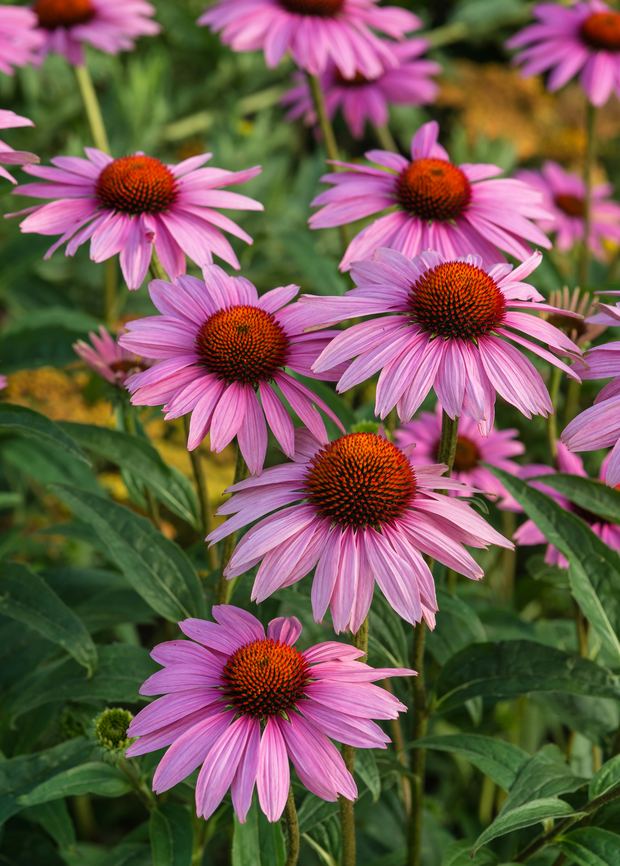
Spring Care: Cut back the dry stalks to the crowns of the plant in early spring.

You can cut back seed heads in the fall, where you don't wish the plant to reseed. Plant it in a wide, shallow depression and mulch amply or place right up against the north side of a low, wide rock, tilted to shed water on the Echinacea's side.įall Care: You can leave the dried seed heads for winter, as they provide food for birds. 'Rocky Top Hybrid' echinacea, while xeric, appreciates extra moisture provided by some easily accomplished water harvesting techniques. Species and cultivars raised from seed will often reseed themselves to continue their presence in our gardens. Healthy individual coneflowers will grow in the garden for 3 to 5 years. and are most commonly found growing in prairie habitats.Įchinacea thrive in our gardens when provided with well drained soils, plenty of sunshine and moderate to dry moisture conditions depending on the species and cultivars. They are native to the eastern half of the U.S. This genus is invaluable for the mid- to late-summer garden, bringing color into our plantings when many spring bloomers have gone green for the season. Their movement and grace are perfect complements to coneflower’s bright beauty and there are numerous varieties from which to choose that often produce fascinating inflorescences to add double interest to the garden.Tips For Growing Echinacea (Purple Coneflower) Ornamental grasses that prefer sunny, well-drained soil are excellent Echinacea companions. Lily turf has strappy leaves, is often variegated, and is hardy in most zones. Outstanding blue-green leaves or burgundy foliage offer options for contrast. Smoke bush may get a little large but is an excellent foliage plant for the back of the perennial garden. Heuchera, or coral bells, are tough perennials with fluted leaves and numerous colors from which to choose. Many of the new coleus cultivars are now just as happy in the sun as they are in shade. If you are wondering what to plant with coneflowers, there are many foliage plants that will provide just the right accent amongst the blooms. Other companion plants for Echinacea might be:Ĭompanion planting with Echinacea isn’t just about the flowers. Goldenrod provides a cloud of lemony blooms, while sedum plants have puffs of pink to yellow flowers on hardy succulent bases. A sea of jewel tones and softer pastels will draw pollinators like a magnet and improve the overall health of your landscape. If you want to bring in the bees, butterflies, and other pollinators, a flowering and fruiting garden can help and there are many brightly colored choices. Pollinator Attracting Companion Planting with Echinacea Other native coneflower companion plants include: Lupines come in an array of tones and are early season color, while hardy geranium creates a carpet of jewel tones and makes an excellent base plant in the bed. Gaillardia has all the tones of a sunset, while black-eyed susan brings cheery yellow and a similar rayed flower. It has bright orange blooms and does indeed attract butterflies. An excellent native to pair with Echinacea is butterfly weed, or Asclepias. Because they are native, they are very adaptable to the existing conditions and do not require as much care as introduced species. Native plants are perfect for the perennial garden. These easy bloomers are hardy to United States Department of Agriculture zones 3 to 9. Echinacea is native to the central and eastern parts of North America. Another garden scheme to consider is to use all natives as companions for Echinacea. When contemplating what to plant with coneflowers, consider other flowering plants as well as foliage superstars to enhance their beauty. Coneflower Companion PlantsĮchinacea produces a rayed flower that spans 2 to 4 inches (5 to 10 cm.) in width. To create a lively color bed, choose Echinacea companions that offer dimension as well as tones and textures that set off these stoic beauties.

Companion plants for Echinacea should have similar cultural requirements and can create a bed with attractive blooms for any beneficial insect. They attract pollinating insects and add statuesque color to a perennial flower garden. These cheery, pinkish-purple flowers can grow up to 3 feet (1 m.) in height with a similar spread.


Echinacea, or purple coneflower, is an outstanding perennial that thrives on neglect.


 0 kommentar(er)
0 kommentar(er)
